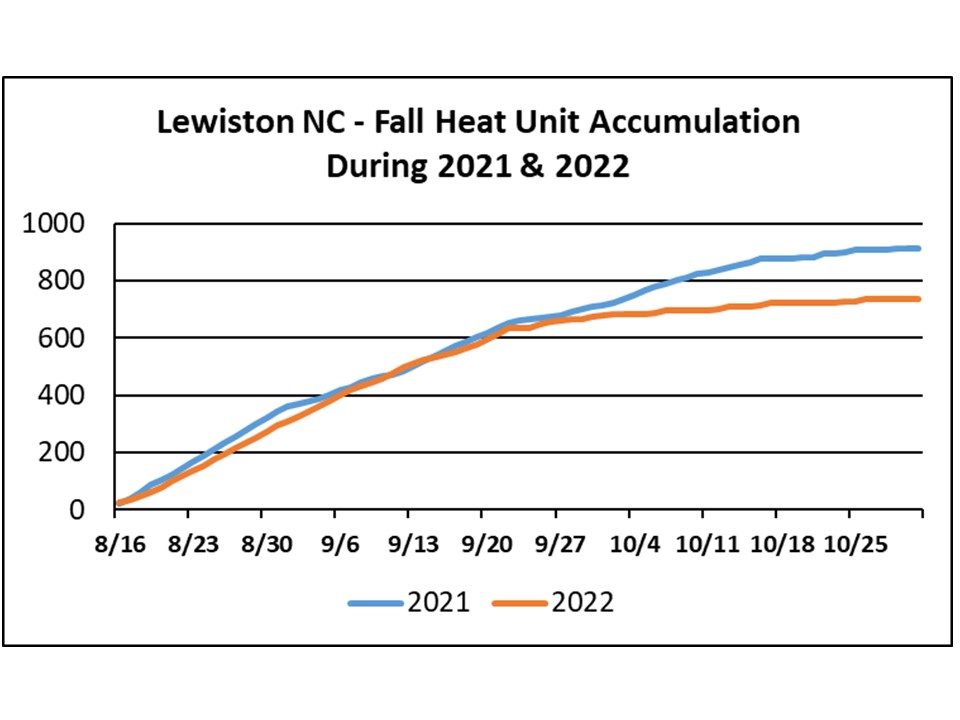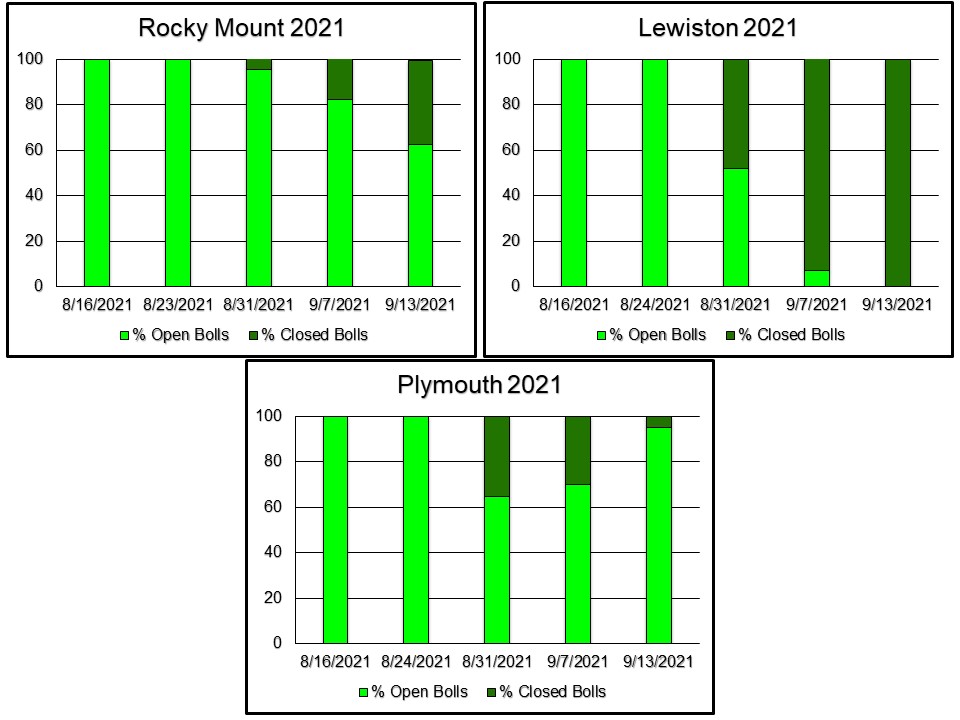When Is the Latest Date That a Bloom Has a Reasonable Chance of Producing a Harvestable Boll? (Collins & Edmisten)
go.ncsu.edu/readext?953373
en Español / em Português
El inglés es el idioma de control de esta página. En la medida en que haya algún conflicto entre la traducción al inglés y la traducción, el inglés prevalece.
Al hacer clic en el enlace de traducción se activa un servicio de traducción gratuito para convertir la página al español. Al igual que con cualquier traducción por Internet, la conversión no es sensible al contexto y puede que no traduzca el texto en su significado original. NC State Extension no garantiza la exactitud del texto traducido. Por favor, tenga en cuenta que algunas aplicaciones y/o servicios pueden no funcionar como se espera cuando se traducen.
Português
Inglês é o idioma de controle desta página. Na medida que haja algum conflito entre o texto original em Inglês e a tradução, o Inglês prevalece.
Ao clicar no link de tradução, um serviço gratuito de tradução será ativado para converter a página para o Português. Como em qualquer tradução pela internet, a conversão não é sensivel ao contexto e pode não ocorrer a tradução para o significado orginal. O serviço de Extensão da Carolina do Norte (NC State Extension) não garante a exatidão do texto traduzido. Por favor, observe que algumas funções ou serviços podem não funcionar como esperado após a tradução.
English
English is the controlling language of this page. To the extent there is any conflict between the English text and the translation, English controls.
Clicking on the translation link activates a free translation service to convert the page to Spanish. As with any Internet translation, the conversion is not context-sensitive and may not translate the text to its original meaning. NC State Extension does not guarantee the accuracy of the translated text. Please note that some applications and/or services may not function as expected when translated.
Collapse ▲This is a question that has come up quite a lot lately, simply because our crop has been late for most of the year. Cool temperatures that prevailed during late May and early June noticeably delayed development of our cotton crop statewide this year, with blooming beginning anywhere from mid to late July, with a few fields entering the bloom period during early August. This obviously compresses our effective bloom period, but by how much?
Yes, this crop has been later than normal for most of the 2023 season. However, extreme heat and drought that we’ve experienced in many areas during August has sped up maturity, and has done so too much, in places. Some fields that received little to no rain in August have already experienced a “hard” cutout and have ceased blooming due to prolonged drought. Delayed maturity is no longer a concern in these areas. A subsequent newsletter article will address crop status in these areas. Other areas that have received rain, are irrigated, or are otherwise still experiencing vigorous growth, are really the only ones that should be concerned about last effective blooming at this point in time.
We’ve done some multi-location research trials over the last two years to revisit Last Effective Bloom Dates (latest date in which 50 percent or more blooms have a reasonable chance at developing into a harvestable boll) in North Carolina, which will continue for the next couple of years. Historically, some have considered our last effective bloom date to be as early as August 15th, and more recently, August 25th, on average. Anecdotal observations over the last several years have suggested that the last effective bloom date could be later than previously thought.
Ultimately, our last effective bloom date depends on Fall weather, primarily heat unit accumulation during September and October, as well as the date of first frost. The slide below illustrates heat unit accumulation from mid-August to the end of October for 2021 and 2022.
Over the last two years, heat unit accumulation during late August and September was nearly identical. However, the month of October was noticeably cooler in 2022 than it was in 2021. October of 2021 brought some warm temperatures, especially during the first half of the month. This was considered a “warmer” Fall but we wouldn’t say that it was exceptionally or abnormally warm. October of 2022 was noticeably cooler than that of 2021, but we wouldn’t say that it was exceptionally cool. The first frost date, for most of NC, was around November 1st during 2021, which is fairly normal. The first frost date during 2022 was around October 20th. Some consider this to be an “early” frost, but we disagree; Looking at historical data and weather patterns, we would say that first frost in 2022 was on the “early end of our normal spectrum” but not abnormally early.
The next two slides illustrate results for last effective bloom dates at multiple locations across the state in 2021 and 2022. During the Fall of 2021, blooming that occurred as late as September 13th had a 60 percent chance of developing into a harvestable boll in two out of three locations in that year. In the northern-most location during 2021, blooming as late as August 31st had a 50 percent chance of developing into a harvestable boll. Keep in mind that the Fall of 2021 was warm, at least through mid October, and the date of first frost was fairly normal.
The 2022 results were a little different. In all locations during 2022, the latest date that blooms had a 50 percent chance of developing into a harvestable boll was August 29th, with a steep decline for blooms that occurred during the first week of September. Keep in mind that October of 2022 was noticeably cooler than that of 2021, with the first frost occurring about 10 days earlier as well.
Conservatively, based on the data we have right now, blooms that are made (and retained) by the end of August have a decent chance of becoming a harvestable boll. If Fall weather is warmer, and if the date of first frost is normal (very late October), we have a decent chance of developing harvestable bolls for blooming that occurs by early to mid-September.
HOWEVER, we have NOT HAD a year since 2020 (before this research began) that brought a noticeably cool September. If you remember during September of 2020, heat unit accumulation was minimal, and maturity had slowed to a crawl during that time. The progression of maturity and boll opening was incredibly slow during the Fall of 2020, and this was reflected in abnormally low micronaire values that year. We have ALSO NOT HAD a very early frost (early October) in several years. Either case would be abnormal for us, but not out of the range of possibility. In years such as that, last effective blooming may be noticeably earlier than what we have observed in 2021 or 2022.
The last slide below illustrates the number of heat units required for blooms to develop into harvestable bolls across both 2021 and 2022. Although there are more factors that influence boll development than heat units alone (moisture, allocation of resources, etc.), there was a fairly high correlation between heat unit accumulation and boll opening. Across both years, the accumulation of approximately 700 heat units (between the date of bloom and boll cracking at or near first frost) was required to essentially “guarantee” that a boll would open. However, if 500 to 600 heat units were accumulated between the date of bloom and first frost, there was a >50 percent chance of that boll opening.
Let’s pray for some more rain (soon) to develop what top crop we have, and a Fall that trends on the warmer side (without excessive rain or Tropical events).






